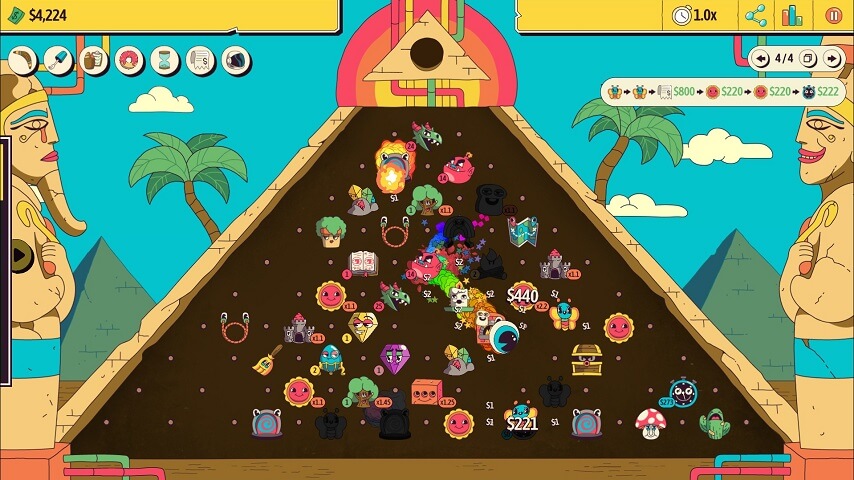Gambling
Not every “gambling but better” game is going to turn out like Balatro

Every Friday, A.V. Club staffers kick off the weekend by taking a look at the world of gaming, diving in to the ideas that underpin the hobby we love with a bit of Game Theory. We’ll sound off in the space above, and invite you to respond down in the comments, telling us what you’re playing this weekend, and what theories it’s got you kicking around.
I actually like Ballionaire. I feel like it’s important to say that here, before I start saying less overtly positive things about newfury’s new Steam game. Attempting to do for Japanese pinball-ish gambling game pachinko what LocalThunk’s Balatro (our No. 1 Game Of The Year for 2024) did for poker, Ballionaire is quick-moving, strategically interesting, brightly colored, and addictive. I’m having a genuinely good time with it, learning the ways it cleverly encourages players to build up degenerate sicko strategies to maximize increasingly ruthless point requirements for each bouncing ball. Honestly, it’s not Ballionaire I have a problem with: It’s pachinko, the game it’s “improving.”
Video games have been toying with pachinko for a good long while at this point, most famously with PopCap’s Peggle, which helped bridge the gap from “gambling” to “game” by giving players far more control over the arc of their dropped balls and transforming pachinko’s traditional peg boards into brightly colored rollercoasters of shapes and dots. (See also Red Nexus Games’ Peglin and Wonderbelly Games’ Roundguard, both of which attempt to build RPG-esque combat out of this same formula.) The physics-based nature of the base game is built into what helps make both Peggle and Ballionaire addictive: The possibility for a really good bounce that gets you way more points/power-ups/loud explosions of fireworks than you were expecting—paired with the irritating sight of watching what should have been a killer shot drain right down the gutter. Good gambling contests sit at an intersection between skill and chance, with the latest trend of gamifying them largely coming from pushing that balance much closer to the “skill” side of the fulcrum by giving players lots of ways to control the randomness. Balatro does that mostly by giving you shockingly varied ways to affect how hands are scored (while also carefully tuning your deck of cards), but Ballionaire works closer to the space of a game like slot machine-improver Luck Be A Landlord, as you transform the board itself to produce lots of chaotic effects.
Some of these are fairly simple: Hitting a Lake tile turns your ball into a water ball, which then has bonus effects if it hits certain other aquatic-themed triggers; bouncing a Brick tile from below—usually with clever placement of bumpers—pops out a coin ball, which can be fed into other objects to maximize profits. As with many games of this ilk, specialization is key, especially as space on the Ballionaire board is limited. Past a certain point, the only way to stay alive is to build an over-stuffed Rube Goldberg machine of triggers, multipliers, and other knock-on effects, allowing the board to explode into huge cascades of balls—as long as the bounces are kind. That’s the game’s purest joy: Watching the line of dominoes you’ve set up topple, as the screen fills with sound and light, much of it moving too fast to parse. It’s a slot machine jackpot that carries an extra sense of satisfaction because you’re the one who made that happen.
But that lack of control over how things ultimately play out is also what makes the game feel like a less satisfying version of the “gambling but better” model, and suggests why some core games are more suited to this approach than others. The deterministic nature of pachinko—i.e., once you’ve launched the ball, it’s out of your control—is central to Ballionaire‘s gameplay. (It resists giving you ways to directly screw with the balls once they’re bouncing, which would turn this into a fundamentally different game.) But it also isn’t nearly as satisfying, long-term, as a game where you have more control over the moment-to-moment play. To delve into one more direct Balatro comparison, a poker hand or deck can be tuned in a million ways (like, say, removing all the spades, or making it so every card is the same number) that still leave the game you’re playing with it feeling fundamentally like poker. (Albeit, weird poker.) But you can’t take the potential for bad bounces out of pachinko without stopping it from being pachinko, and that doesn’t line up with the increasingly rigid score requirements Ballionaire wants you to hit as you progress through its tiers of play. Better, smarter board design from me, the player, would let me correct for this, of course, but that’s part of the issue: At that point, I’m just playing a sort of oddball optimization puzzle, creating clockwork machines that crap out points in the most efficient ways possible, and both the thrill of exploration, and the gamble of the bounce, are gone. To put it another way: You can take the risk element out of poker, and still have a game; with pachinko, Ballionaire suggests, you can only have one or the other.










